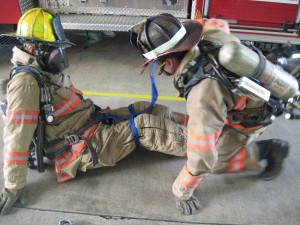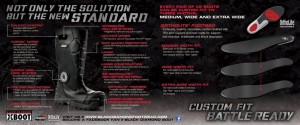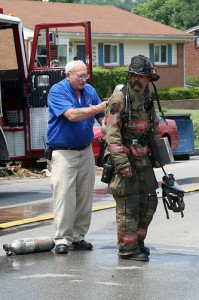 There have been several incidents lately where “MAYDAY” was transmitted and RIT / RIC (Rapid Intervention Team, Rapid Intervention Crew) was activated. Dave Statter has coverage of the 5 firefighters injured in Washington DC HERE . Chris Naum has coverage over at Command Safety on the DOUBLE MAYDAY transmission in the Borough of Queens NY. Find that article HERE .
There have been several incidents lately where “MAYDAY” was transmitted and RIT / RIC (Rapid Intervention Team, Rapid Intervention Crew) was activated. Dave Statter has coverage of the 5 firefighters injured in Washington DC HERE . Chris Naum has coverage over at Command Safety on the DOUBLE MAYDAY transmission in the Borough of Queens NY. Find that article HERE .
I hope everyone takes the time to follow these stories and then think about what you or your crew would do if found in the same situation. My mind has been on RIT and self rescue techniques so that was our company drill today. It was a good refresher for me and my crew so I thought I’d share a little of it with you folks.
I have missed the last few weeks of my “Tricks of the Trade” so this fill that gap a little as well (Thanks to Lt. Lee Powell of Burnt Chimney Vol. Fire Department for requesting Tricks of the Trade)
I’m gonna skip over a ton of stuff and get right to the point “trick” I want to focus on…. The “ROCK” and “RAY” harness to assist in removing a downed firefighter.
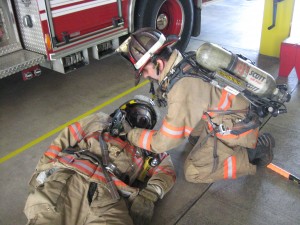 The “ROCK” is a technique used to turn a firefighter’s SCBA into a better “harness” for dragging. Think about it …. it’s already there and attached to the firefighter … so USE IT.
The “ROCK” is a technique used to turn a firefighter’s SCBA into a better “harness” for dragging. Think about it …. it’s already there and attached to the firefighter … so USE IT.
The “Rock” allows us to drag the firefighter by his SCBA and not PULL IT OFF OF HIM/HER. How many stories have you heard of members pulling the SCBA and / or coats off of downed firefighters while attempting to drag them out of a structure? This quick and simple technique will help avoid that while giving you move leverage options while performing the rescue.
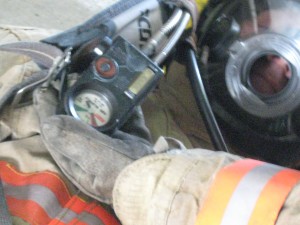 After locating the downed firefighter …. check to see that he is breathing and on his remaining air supply. If unconscious, listen for the breaths while checking his gauges.
After locating the downed firefighter …. check to see that he is breathing and on his remaining air supply. If unconscious, listen for the breaths while checking his gauges.
Our RIT Bag has several options to supply the downed firefighter with air. My Department uses the Scott AP50, 2002 edition. We have the option to “Buddy Breath” (not recommended in this situation because it “ties” you too close to the downed firefighter). We can do a “quick fill” of his bottle. We could also connect his face piece / regulator to our RIT bottle or change his mask out to the RIT mask / regulator and bottle.
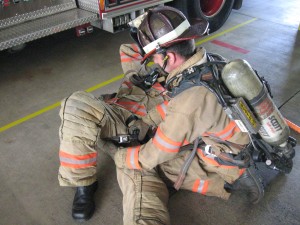 After getting the downed firefighter “on air” (or while your partner is doing so) you need to place him in the “harness”
After getting the downed firefighter “on air” (or while your partner is doing so) you need to place him in the “harness”
To do this, start by loosening his shoulder and waist straps. Do the shoulder straps first, then move down his body to the waist. After loosening the waist strap, unbuckle it.
Reposition one end of the waist strap under the leg on that side of his body and reconnect the buckle. You should now have the waist strap running between the downed firefighters legs.
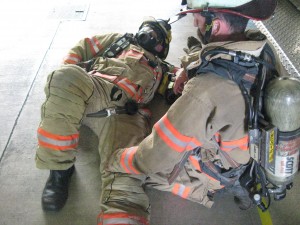 Now, re-tighten both the waist and shoulder straps.
Now, re-tighten both the waist and shoulder straps.
You can now drag / pull the downed firefighter by his SCBA without fear of pulling it off of him / her.
This harness should be used when removing the firefighter head first (the RAY is the better option for feet first drags).
I prefer a head first drag because it allows the victims arms and legs to naturally fall in-line with the body reducing the risk of snags and obstructions.
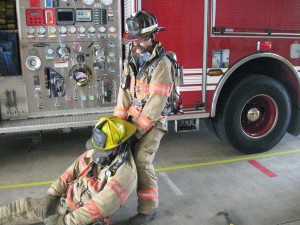 Again, at this point; you have many options available to you.
Again, at this point; you have many options available to you.
You can simply grab the shoulder straps and begin your drag.
This technique gets the downed firefighter’s SCBA up and off the floor but offers very little in leverage.
It also keeps or places your feet close to the downed firefighter forcing you to use short choppy steps.
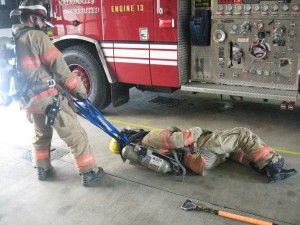 Another option would be to use a piece of webbing through the shoulder straps.
Another option would be to use a piece of webbing through the shoulder straps.
This technique allows the rescuer to put some distance between himself and the downed firefighter. Depending on the length of the webbing, it still allows the rescuer to gain some “lift” on the downed firefighter again reducing snags / obstructions.
In this position, I could also turn and face forward while conducting the drag.
Another advantage here is that is room permits, 2 rescuers can perform the drag..(one pulling from each end of the webbing).
If your RIT / RIC operates with a “search rope”, you could even attach the rope to the SCBA harness with a beaner and have members from outside pulling as well … you are NOT going to pull the SCBA off in this position.
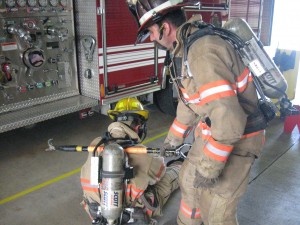 Another option is to use a tool through the shoulder straps.
Another option is to use a tool through the shoulder straps.
This is obviously a two rescuer option with advantages and disadvantages.
The biggest limitation is having the space to utilize this option. In a residential structure, most hall or doorways wont allow this width (the 2nd rescuer would be on the pike end of the pole).
Should space allow this technique, it works very well. It allows each rescuer to be just off to the side of the downed firefighter while facing forward. It also allows for the rescuers to have lift on the downed firefighter which again reduces snags and obstruction.
Another option (which I didn’t photograph) is placing a charged hose line through the straps. If the nozzle has a pistol grip, it will act as a “hook” on the straps while you and your company pull the hose out of the structure. If you don’t have a pistol grip nozzle (or don’t trust it’s strength) simply run the hose several feet through and point the nozzle in the direction you’re gonna pull (out). Put your crew of however many behind the nozzle as if advancing it out. You can then radio out to the engine and have members out side begin to pull the hose out of the structure. While they are pulling, your crew advances out . The downed firefighter is drug from the “bite” created in the hose.
So that’s the “ROCK” in a nutshell. Remember that this is used for dragging a downed firefighter HEAD FIRST. The key to this drag is getting that waist strap under the leg and through the crotch. I would also utilize this harness for lifting a downed firefighter (as in through a hole in the floor etc).
The next harness is the “RAY”. It can be used when dragging feet first.
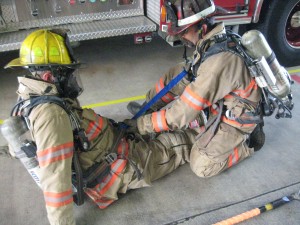 Again, this harness utilizes the SCBA which should already be in place.
Again, this harness utilizes the SCBA which should already be in place.
After getting the Firefighter on air, unbuckle the waist strap and re-fasten it through a piece of webbing (looped webbing)
You can also just run the webbing behind the waist strap and then through itself.
The next step is to place 2 half hitches in the webbing around the downed firefighters legs.
One above the knees, the second below.
Of course the length of you webbing is a key element here.
A single half hitch will work but I have found that using two works better.
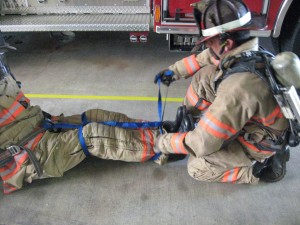 After the 2nd hitch is in place, you’re ready to pull.
After the 2nd hitch is in place, you’re ready to pull.
Again, depending on the length of your webbing, this could be a single or multiple rescuer drag.
The length of the webbing also determines how far away from the downed firefighter the rescuer is able to get while pulling.
This technique is not the optimal in my opinion.
Although you get lift on the legs, the SCBA remains on the ground and is subject to drag, snags and obstructions.
Dragging feet first also allows the downed firefighter’s arm to open up and away from his / her body during the drag again adding to the likelyhood of snags etc.
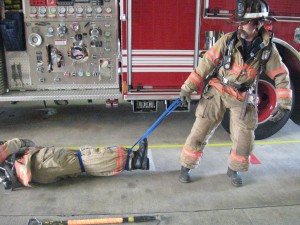 The downed firefighter’s helmet also becomes a hindrance with this technique…. both to you and them. The helmet IS GOING TO DRAG and, with the chin strap securely fastened; will be choking him every foot of the way. It’s a judgement call but you may consider removing the helmet (or replacing it with a “rescue” helmet from your RIT bag ) when securing his air supply.
The downed firefighter’s helmet also becomes a hindrance with this technique…. both to you and them. The helmet IS GOING TO DRAG and, with the chin strap securely fastened; will be choking him every foot of the way. It’s a judgement call but you may consider removing the helmet (or replacing it with a “rescue” helmet from your RIT bag ) when securing his air supply.
The bottom of the SCBA bottle is also a huge henderance with this technique. Because this end of the bottle is not rounded like the top, it also catches and snags everything.
The downed firefighter’s coat does the same thing and will “ride up” to the SCBA waist strap.
Not a pretty drag ( did you guys catch the quote from Kelly Grayson’s post today? … “just think of it like a supermodel with an STD: nice to look at, but not so much to play with” ). LMAO .. well, this drag is the same way. It does give you some options and leverage when you are forced to pull feet first though. Otherwise, you would pull the pants and boots right off this firefighter before you ever got him out.
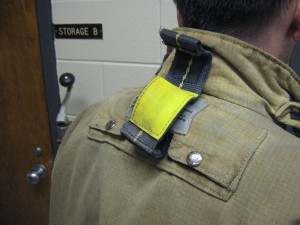 Another hint is don’t forget the “built in” systems.
Another hint is don’t forget the “built in” systems.
A new option from Scott is the “Scott DRL” or Drag Rescue Loop.
I wear Morning Pride Turn Out Gear with an intergrated DRD or Drag Rescue Device .
So there ya have it. Hopefully a couple helpful hints or “Tricks of the Trade” to help you out in a RIT activation. I hope you never have to use them but also hope you are trained and ready should you ever have to.
Thanks as always for reading / following. Please take the time to “Share” “Recommend” “Like” and “Tweet”.
Don’t forget to click here and submit your picture for our Black Diamond X2 Boot Give Away!
The Deadline for entries is Midnight on Wednesday April 13, 2011.
Stay safe and in house!
Captain Wines
 Iron Firemen Wooden Ladders & Iron Firemen
Iron Firemen Wooden Ladders & Iron Firemen
